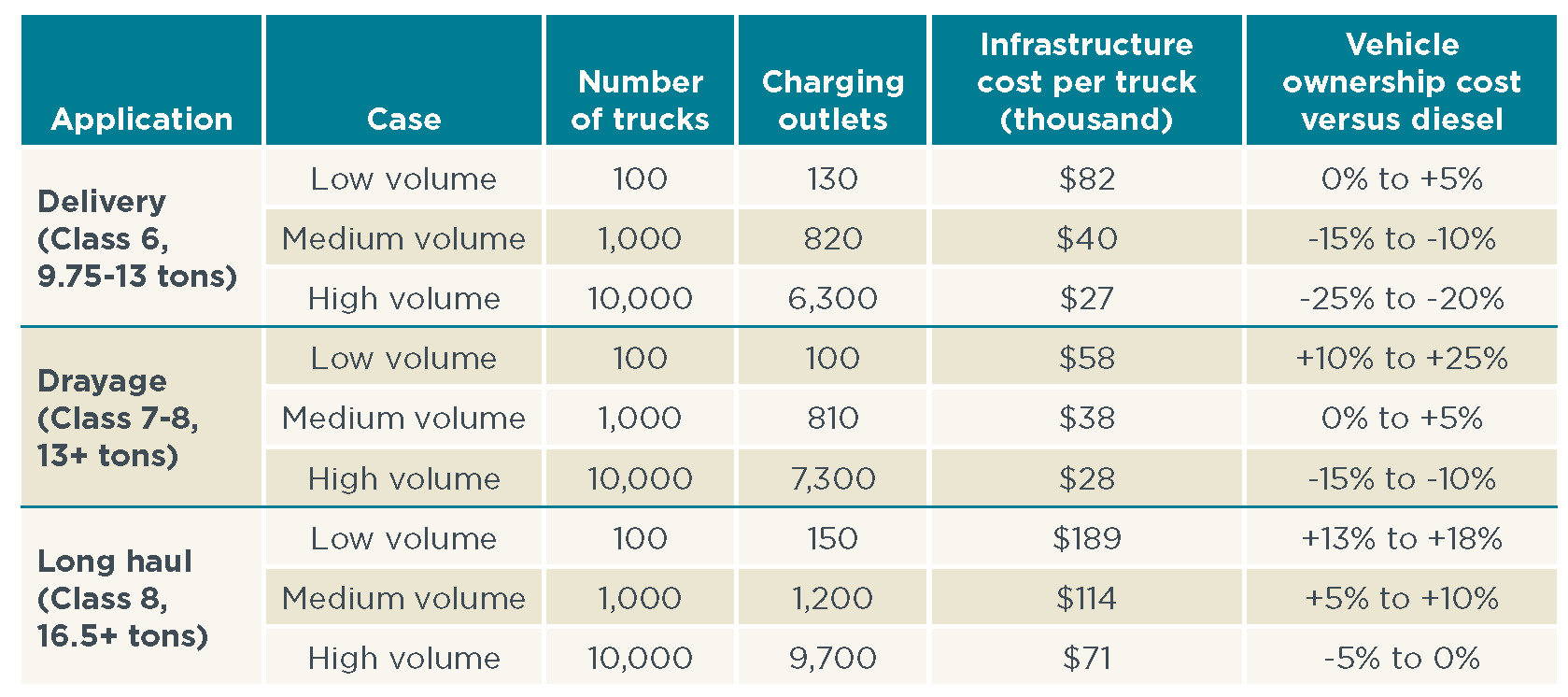White paper
Estimating the infrastructure needs and costs for the launch of zero-emission trucks
This paper quantifies the infrastructure needs and associated costs for implementing battery electric and hydrogen fuel cell trucks in three applications: long-haul intercity tractor-trailers, drayage trucks, and medium-duty delivery trucks.
The table below summarizes the charging requirements and costs as the number of trucks increases from 100 to 1,000 to 10,000 in each of the three applications. The total infrastructure costs are substantial, into the hundreds of millions of dollars to reach 10,000 electric trucks for each of the three applications. However, infrastructure costs per vehicle decline as truck volume grows. The last column shows that, even if fleets were to bear these associated infrastructure costs, the overall vehicle ownership cost of electric trucks in these applications will generally be lower than conventional vehicle costs by 2030. Public infrastructure funding or other fiscal incentives could further improve the cost of ownership proposition.

Although we highlight only the electric truck findings in this table, equivalent findings for hydrogen fuel cell trucks are also assessed in the report. Infrastructure for the hydrogen pathway is generally costlier than battery electric for long-haul and delivery applications, while it is less expensive for drayage trucks.
The analysis draws the following conclusions:
Declining technology costs are making zero-emission trucks increasingly cost-competitive with conventional diesel vehicles. Although zero-emission trucks are more expensive in the near-term than their diesel equivalents, electric trucks will be less expensive than diesel in the 2025–2030 time frame, due to declining costs of batteries and electric motors. Fuel cell trucks will also become less expensive in upfront vehicle cost and total cost of ownership by 2030 as a result of declining vehicle and hydrogen fuel costs.
In contrast, increasing fuel and vehicle costs are projected to outweigh savings from efficiency improvements for diesel tractor-trailers in the 2025 to 2030 time frame, resulting in a higher lifetime cost for a truck purchased in 2030 than in 2025. This suggests that the TCO and upfront price savings for zero-emission tractor-trailer options will only accelerate after 2030.
Infrastructure costs are significant, but do not fundamentally impede the viability of zero-emission trucks. As fleets deploy zero-emission trucks at greater scale, infrastructure costs add more than $70,000 per battery electric long-haul tractor-trailer and more than $25,000 per drayage truck or delivery truck, amounting to 7% to 9% of the lifetime operating cost in each application. If these infrastructure costs are excluded, electric fleets could see vehicle ownership cost parity with diesel in the early 2020s; including these infrastructure costs pushes parity five to 10 years later.
Initial infrastructure buildouts will require careful planning and coordination. In the early zero-emission truck deployments, it will be essential to plan infrastructure for specific routes, applications, and duty cycles to minimize costs. For electric trucks, overnight and loading area charging can greatly reduce charging costs, and coordination among fleets and public agencies could help distribute the initial costs. Government-led programs and public-private partnerships would help coordinate and share such investments.
